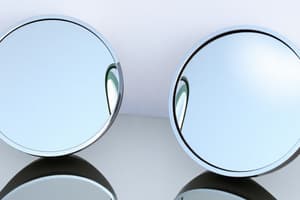Podcast
Questions and Answers
What is the direction of the distance measured when a negative sign is used in the sign convention?
What is the direction of the distance measured when a negative sign is used in the sign convention?
- Parallel to the principal axis
- In the direction of the incident ray
- Perpendicular to the principal axis
- Opposite to the direction of the incident ray (correct)
What is the focal length of a convex mirror according to the sign convention?
What is the focal length of a convex mirror according to the sign convention?
- Zero
- Positive
- Negative (correct)
- Infinity
What is the height of the image taken as for a real image?
What is the height of the image taken as for a real image?
- Negative (correct)
- Infinity
- Positive
- Zero
What is the purpose of the mirror formula in a convex mirror?
What is the purpose of the mirror formula in a convex mirror?
What is the magnification of a spherical mirror represented by?
What is the magnification of a spherical mirror represented by?
What is the radius of curvature of the convex mirror in the example given?
What is the radius of curvature of the convex mirror in the example given?
What is the purpose of using concave mirrors in solar furnaces?
What is the purpose of using concave mirrors in solar furnaces?
What is shown in Fig. 5(a) and Fig. 5(b)?
What is shown in Fig. 5(a) and Fig. 5(b)?
What is the formula that relates the object distance, image distance, and focal length of a spherical mirror?
What is the formula that relates the object distance, image distance, and focal length of a spherical mirror?
According to the sign convention for reflection by spherical mirrors, where is the object always placed?
According to the sign convention for reflection by spherical mirrors, where is the object always placed?
What can be said about the image formed by a convex mirror?
What can be said about the image formed by a convex mirror?
What is the term for the distance of the principal focus from the pole of a spherical mirror?
What is the term for the distance of the principal focus from the pole of a spherical mirror?
Where is the principal focus of a spherical mirror located?
Where is the principal focus of a spherical mirror located?
What is the nature of the image formed by a concave mirror when the object is placed between the focal point and the mirror?
What is the nature of the image formed by a concave mirror when the object is placed between the focal point and the mirror?
What is the purpose of using concave mirrors in torches, search-lights, and vehicles headlights?
What is the purpose of using concave mirrors in torches, search-lights, and vehicles headlights?
What determines the size of the image formed by a concave mirror?
What determines the size of the image formed by a concave mirror?
What is the nature of the image formed by a concave mirror when the object is placed beyond the focal point of the mirror?
What is the nature of the image formed by a concave mirror when the object is placed beyond the focal point of the mirror?
What is the purpose of using ray diagrams in mirror optics?
What is the purpose of using ray diagrams in mirror optics?
Flashcards are hidden until you start studying
Study Notes
Sign Convention for Spherical Mirrors
- Distances parallel to the principal axis are measured from the pole (P) of the mirror.
- Negative sign indicates distance measured in the direction opposite to the incident ray, while positive sign indicates distance measured in the direction of the incident ray.
- Distance below the axis is negative, while distance above is positive.
- Focal length (f) is positive for a concave mirror and negative for a convex mirror.
Magnification of Spherical Mirrors
- Magnification (m) is given by m = hi/uo = -ho/u, where hi is the height of the image and ho is the height of the object.
- Height of the object is taken as positive, as it is usually placed above the principal axis.
- Height of the image is taken as positive for virtual images and negative for real images.
Image Formation by Convex Mirrors
- Image formation by a convex mirror can be understood through ray diagrams for two positions of the object: at infinity and at a finite distance from the mirror.
- Results are summarized in Table 2, showing nature, position, and relative size of the image formed by a convex mirror.
Mirror Formula and Magnification
- Mirror formula: 1/v + 1/u = 1/f, relating object distance (u), image distance (v), and focal length (f).
- Formula is valid for all spherical mirrors and all positions of the object.
Image Formation by Concave Mirrors
- Image formation by a concave mirror depends on the position of the object in relation to points P, F, and C.
- Nature, position, and size of the image formed by a concave mirror vary depending on the object's position.
- Image is real for some positions of the object and virtual for others.
- Image is either magnified, reduced, or has the same size, depending on the object's position.
Uses of Concave Mirrors
- Concave mirrors are used in torches, search-lights, and vehicles' headlights to produce powerful parallel beams of light.
Studying That Suits You
Use AI to generate personalized quizzes and flashcards to suit your learning preferences.



